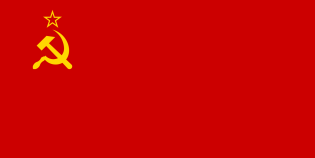Union of Soviet Socialist Republics
| |||||
 | |||||
|---|---|---|---|---|---|
| National Flag | |||||
| Astrography | |||||
| Sovereignty | |||||
|
Formation |
7 November 1917
30 December 1922
31 January 1924 | ||||
| Demographics | |||||
|
Demonym(s) |
Soviet | ||||
|
Population |
32,054,300,000 (2285 estimate) | ||||
|
Languages |
| ||||
| Infrastructure | |||||
| Astropolitics | |||||
 | |||||
| Starmap Roundel | |||||
|
Classification |
|||||
|
LoN Status |
|||||
|
Membership(s) |
|||||
The Union of Soviet Socialist Republics, commonly known as the Soviet Union (USSR), is a Legacy Nation situated predominantly in the Zhar Ptitsa. It is the most populous nation in the Orion Arm. The USSR is a Superpower, a founding member of the Communist Interstellar, a member of the Arusha Pact, and is a Security Council Member of the modern League of Nations. It is a flagship communist state.
History
Pre-First Scinfaxi War
Human settlement on the Earth territories of the Soviet Union dates back to the Lower Paleolithic. The East Slavs emerged as a recognized group in Europe between the 3rd and 8th centuries CE. The first East Slavic state, Kievan Rus', arose in the 9th century, and in 988, it adopted Orthodox Christianity from the Byzantine Empire. Kievan Rus' ultimately disintegrated; the Grand Duchy of Moscow led the unification of Russian lands, leading to the proclamation of the Tsardom of Russia in 1547. By the early 18th century, Russia had vastly expanded through conquest, annexation, and the efforts of Russian explorers, developing into the Russian Empire, which became one of the largest in Earth's history.
However, with the Russian Revolution in 1917, Russia's monarchic rule was abolished and eventually replaced by the Russian SFSR - the world's first constitutionally socialist state, led by Vladimir Lenin. The revolution was not accepted by all within the Russian Republic, resulting in the Russian Civil War. In 1922, following the Russian Civil War, the Russian SFSR, Ukrainian SSR, Byelorussian SSR, and Transcaucasian SFSR united into the Soviet Union - with federal bodies of political power historically located in the capital of Moscow. Each union republic retains state sovereignty and the right to freely withdraw from the Union. Following Lenin's death in 1924, Joseph Stalin came to power, inaugurating rapid industrialization and forced collectivization that led to significant economic growth but contributed to a famine between 1930 and 1933 that killed millions.
The Cold War
Distant Interstellar Warning Line
Established during the Evacuation Effort of Earth, the Distant Interstellar Warning Line was created to act as a international trip-wire for Scinfaxi activity. At its height, the Union of Soviet Socialist Republics, Greater German Reich, and United Kingdom deployed nearly ten-thousand automated sensor buoys and dozens of manned station. By the 2260s, the Soviet Union had withdrawn from the program.
Soviet-Reich Conflict
First Vega War
Fleet Action Off Vega
Contemporary Issues
|
References
- "Fleet Action Off Vega", Champlain Group.
- "Red Army Deploys Pre-Positions Modules To Vega", Champlain Group
- "Thousands Feared Dead On Soviet Agri-World As Mass Unexplained Firestorms Rage", Champlain Group
- ''Volgograd System Will Return to Historic Name of “Stalingrad”", Champlain Group.
- "Last Remaining Stations In 'Distant Interstellar Warning Line' To Be Decommissioned By 2289", Champlain Group
- "Soviet Union Rifleman", Champlain Group
| Superpowers of the Orion Arm |
|---|